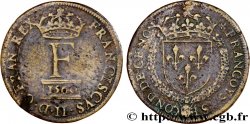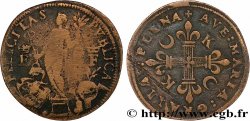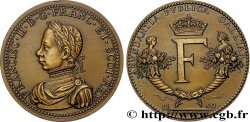fme_860903 - FRANÇOIS II Médaille, Traité d’Édimbourg, refrappe
100.00 €
Количество
Добавить в корзину

Тип Médaille, Traité d’Édimbourg, refrappe
Дата: (1560)/1972
Монетный двор / Город: Monnaie de Paris
Металл: bronze
Диаметр: 53,5 mm
Ориентация осей монеты: 12 h.
Вес: 71,38 g.
Век: lisse + 1972 + corne BRONZE
Пуансон: corne BRONZE
Комментарии о состоянии
Médaille sous scellé plastique
Лицевая сторона
Аверс: легенда: FRANCISC. II. D. G. FRANC. ET. SCOT. REX.
Аверс: описание: Buste laurée de François II à gauche.
Обратная сторона
Реверс: легенда: ABVNDANTIA PVBLICA GALLIAR // 15 - 60 // À L’EXERGUE : PAX. CVM. ANCLIS.
Реверс: Описание: F couronné entre deux corne d’abondances personnifiées.
Комментарий
Médaille dans son sachet scellé et sa boîte bleue de la Monnaie de Paris.
Le traité d'Édimbourg met fin en partie à la Vieille alliance (The Auld Alliance) entre l'Écosse, la Norvège et la France.
Cette alliance avait été renforcée au XVIe siècle par des mariages entre la couronne d'Écosse et celle de France. Mais le parlement écossais, très favorable au protestantisme, avait décidé de mettre fin à la guerre avec l'Angleterre, de reconnaître Élisabeth Ire pour reine d'Angleterre et d'instaurer la nouvelle religion comme culte officiel. La France renonçait, en signant le Traité d'Édimbourg, à tous ses droits sur l'Écosse, ses droits lui venaient par la reine d'Écosse Marie Stuart, épouse de François II de France et fille de Marie de Guise et du roi Jacques V d'Écosse. La mort de François II le 4 décembre 1560 laissait Marie Stuart veuve à 19 ans. Elle passe un accord avec son demi-frère James (fils naturel de Jacques V) le 15 août 1561 qui lui permet de rentrer en Écosse en souveraine à condition de ne pas chercher à rétablir le catholicisme en tant que religion d'État. Ce retour de Marie Stuart sur le trône d'Écosse sera de courte durée puisqu'en 1567, elle sera forcée d'abdiquer au profit de son fils Jacques VI et Ier.
Ainsi se terminait la Vieille alliance entre la France et l'Écosse, même si certaines clauses perdurèrent jusqu'en 1903..
Medal in its sealed bag and its blue box from the Monnaie de Paris.
The Treaty of Edinburgh partially ends the Old Alliance (The Auld Alliance) between Scotland, Norway and France.
This alliance was reinforced in the 16th century by marriages between the crown of Scotland and that of France.. But the Scottish Parliament, very favorable to Protestantism, had decided to end the war with England, to recognize Elizabeth I as Queen of England and to establish the new religion as the official cult.. By signing the Treaty of Edinburgh, France renounced all its rights over Scotland, rights which came to it through the Queen of Scotland, Mary Stuart, wife of Francis II of France and daughter of Mary of Guise and King James V of Scotland.. The death of Francis II on December 4, 1560 left Mary Stuart a widow at the age of 19.. She made an agreement with her half-brother James (the natural son of James V) on 15 August 1561 which allowed her to return to Scotland as sovereign on condition that she did not seek to re-establish Catholicism as the state religion.. This return of Mary Stuart to the throne of Scotland would be short-lived since in 1567, she would be forced to abdicate in favor of her son James VI and I..
Thus ended the Old Alliance between France and Scotland, although some clauses lasted until 1903..
Le traité d'Édimbourg met fin en partie à la Vieille alliance (The Auld Alliance) entre l'Écosse, la Norvège et la France.
Cette alliance avait été renforcée au XVIe siècle par des mariages entre la couronne d'Écosse et celle de France. Mais le parlement écossais, très favorable au protestantisme, avait décidé de mettre fin à la guerre avec l'Angleterre, de reconnaître Élisabeth Ire pour reine d'Angleterre et d'instaurer la nouvelle religion comme culte officiel. La France renonçait, en signant le Traité d'Édimbourg, à tous ses droits sur l'Écosse, ses droits lui venaient par la reine d'Écosse Marie Stuart, épouse de François II de France et fille de Marie de Guise et du roi Jacques V d'Écosse. La mort de François II le 4 décembre 1560 laissait Marie Stuart veuve à 19 ans. Elle passe un accord avec son demi-frère James (fils naturel de Jacques V) le 15 août 1561 qui lui permet de rentrer en Écosse en souveraine à condition de ne pas chercher à rétablir le catholicisme en tant que religion d'État. Ce retour de Marie Stuart sur le trône d'Écosse sera de courte durée puisqu'en 1567, elle sera forcée d'abdiquer au profit de son fils Jacques VI et Ier.
Ainsi se terminait la Vieille alliance entre la France et l'Écosse, même si certaines clauses perdurèrent jusqu'en 1903..
Medal in its sealed bag and its blue box from the Monnaie de Paris.
The Treaty of Edinburgh partially ends the Old Alliance (The Auld Alliance) between Scotland, Norway and France.
This alliance was reinforced in the 16th century by marriages between the crown of Scotland and that of France.. But the Scottish Parliament, very favorable to Protestantism, had decided to end the war with England, to recognize Elizabeth I as Queen of England and to establish the new religion as the official cult.. By signing the Treaty of Edinburgh, France renounced all its rights over Scotland, rights which came to it through the Queen of Scotland, Mary Stuart, wife of Francis II of France and daughter of Mary of Guise and King James V of Scotland.. The death of Francis II on December 4, 1560 left Mary Stuart a widow at the age of 19.. She made an agreement with her half-brother James (the natural son of James V) on 15 August 1561 which allowed her to return to Scotland as sovereign on condition that she did not seek to re-establish Catholicism as the state religion.. This return of Mary Stuart to the throne of Scotland would be short-lived since in 1567, she would be forced to abdicate in favor of her son James VI and I..
Thus ended the Old Alliance between France and Scotland, although some clauses lasted until 1903..







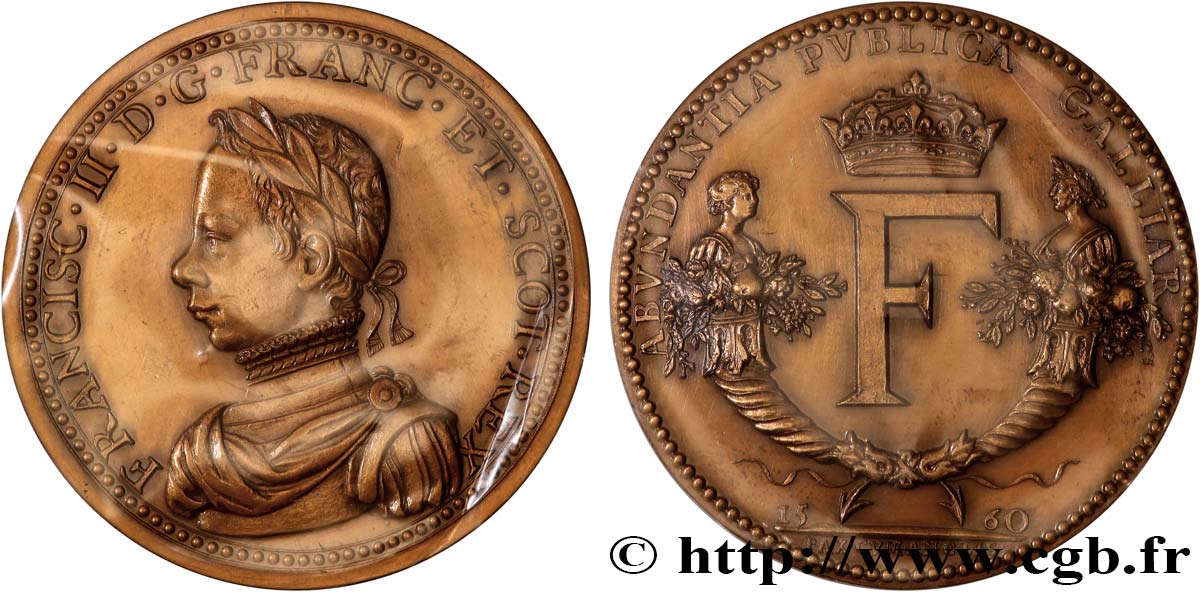
 Cообщить об ошибке
Cообщить об ошибке Распечатать страницу
Распечатать страницу Отправить мой выбор
Отправить мой выбор Задать вопрос
Задать вопрос Consign / sell
Consign / sell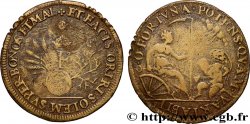
 Информация
Информация
